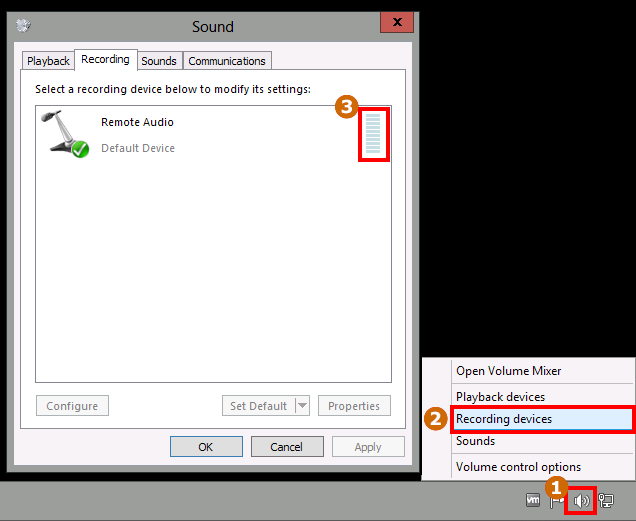Using audio with a VM
Windows VMs can be configured to allow audio over RDP connections in the Secure Remote Access (SRA) browser client. Audio input and output work with the microphone and speakers attached to your local computer.
Notes
- Audio is supported only on VMs that host specific versions of Windows Server. For a list of supported Windows Server versions, see Enabling audio for a VM.
- This article assumes that the operating system and VM settings have already been properly configured for VM audio. If you're a Kyndryl Cloud Uplift user who needs to configure a VM, see Enabling audio for a VM. If you're a student using a VM through a sharing portal, these settings should already be configured for you.
Contents
Supported browsers
Audio input and output for Kyndryl Cloud Uplift VMs is supported for the following browsers:
- Google Chrome (recommended)
- Mozilla Firefox
Kyndryl Cloud Uplift audio features aren’t available for Apple Safari.
Using audio for the first time
To connect to the VM and test your audio connection:
-
Within Kyndryl Cloud Uplift or a sharing portal, open the browser client by clicking on the thumbnail image of a running VM.

-
Check the browser client toolbar to view the current audio settings and make sure RDP is in use (
 ).
).

- Click the RDP button to display the Connection Type and Audio settings and switch between two connection types:
- Standard (no audio) – Connect to the VM using the default Kyndryl Cloud Uplift connection type. This connection type doesn’t support VM audio.
- RDP (audio capable) – Connect to the VM over RDP. RDP is required for VM audio. If you switch to RDP from Standard, you must sign back into the Windows operating system.
- The toolbar and Connection Type and Audio menu display information about the enabled VM audio input and output settings. These settings can’t be edited from this toolbar; they’re managed in the VM hardware settings by the VM owner.
 – Audio input is enabled for the VM and this browser session.
– Audio input is enabled for the VM and this browser session.-
 – Audio input is enabled for the VM but is assigned to another user. This icon also displays if audio is enabled for the VM but the audio service failed to start.
– Audio input is enabled for the VM but is assigned to another user. This icon also displays if audio is enabled for the VM but the audio service failed to start.If the toolbar doesn't display the RDP button or audio information, the VM isn't configured for audio use.
- If you have permissions to edit the VM in Kyndryl Cloud Uplift, see Enabling audio for a VM.
- If you're using an environment that has been shared with you, contact your instructor or administrator.
-
If the VM is controlled by another user, a reduced version of the toolbar displays. The RDP icon is dimmed and the audio input icon shows that audio input is disabled on your browser.
If you aren’t the owner of the VM, you can’t change the display quality settings.
To take ownership of the VM so that audio input is assigned to your browser, click Take Control in the toolbar.

-
To use audio input, your browser must be configured allow audio input from the microphone. Check your browser settings to make sure the microphone is allowed. These instructions vary by browser. For example:
- Chrome instructions: Use your camera and microphone in Chrome.
- Firefox instructions: Enabling the microphone in Firefox.
-
Test your speakers and microphone.
To test your speakers (for audio output) – Windows Server 2012 R2
- Right-click the speaker icon in the notification area of the Windows VM toolbar.
- Select Sounds.
- Select a sound from the menu and click Test. The audio plays from your computer speakers.

To test your microphone (for audio input) – Windows Server 2012 R2
- Right-click the speaker icon in the notification area of the Windows VM toolbar.
- Select Recording devices. The Recording tab of the Sound dialog displays, which shows the recording devices for the VM. You should see a microphone icon with an audio meter.
- Try speaking into the computer microphone. If audio is correctly configured for the VM, the audio meter responds to the level of your voice.

Troubleshooting
If you have trouble using VM audio, or if an error message displays in the browser toolbar, see Troubleshooting VM audio.
